new posts in all blogs
Viewing Blog: Tara Lazar, Most Recent at Top
Results 1 - 25 of 638

"A little nonsense now and then is relished by the wisest men." -Roald Dahl
Statistics for Tara Lazar
Number of Readers that added this blog to their MyJacketFlap: 18
by Hillary Homzie and Mira Reisberg
You have an idea for a book! Yahoo! It’s one of those ideas that hits you so deep in your gut that you immediately scribble it into a little notebook. Your stomach bubbles, not in an indigestion sort of way, but in a nervous-happy–giving-birth-to-a-germ-of-an-idea way. So how do you know if the idea is really picture book idea? What if it’s actually a chapter book or a middle grade novel, how do you know?
Well, you don’t. Not right away.
Of course, there are the obvious tip-offs that your idea is not a picture book. Take your idea through this list and see how it stacks up.
- Age of the protagonist.
These days picture books are generally geared for ages 2-7, although there are still picture books geared towards older elementary school, especially in nonfiction. Still, there’s no question that picture books are skewing younger with shorter word counts. If your primary character is in first through third grade (or ages 6-9), and is longer than 700 words, chances are you have a chapter book. And if your character is a fourth or fifth grader, chances are you have a younger middle grade novel (for ages 9-10). Now sometimes, often, older chapter books overlap with middle grade. Is Stuart Little an illustrated chapter book or an early middle grade? There is no hard and fast answer here, especially since the term chapter book has often been used in a general way to indicate a book for elementary school children that has chapters. However, often in publishing when we say chapter book, we often mean an early chapter book. Think Magic Tree House, Junie B. Jones or Geronimo Stilton. Of course, exceptions apply in everything (and really, would it be any fun if there weren’t?). But read on to help you determine where your idea fits best.

- Interest of the main character.
Is your main character interested in something that will be appealing to younger children? E.g. If you’re story is about a child who’s excited about writing cursive, this means the main character is probably eight, and chances are it’s a chapter book story. If you’re an author/illustrator who has created lots of charming or edgy black and white illustrations to go with the story, chances are it’s a chapter book. Early middle grade books are also starting to feature illustrations more. This is great news for illustrators.

Page from “Notebook of Doom” chapter book series by Troy Cummings
- Period of time.
Does your story occur over a year? Six months? You may have a chapter book or young middle grade on your hands. Now there are exceptions, picture books such as Diary of a Worm, which chronicles a character over a large period of time, or nonfiction picture books that occur over a long time like biographies. The majority of contemporary picture books take place over a brief period of time, while chapter or middle grade books usually have the luxury of taking their time with a story.
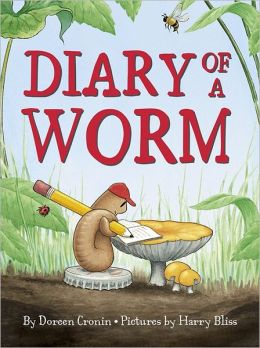
- Type of protagonist.
Are your main characters animals or personified objects? Chances are it’s either a picture book or an early chapter book. Older kids generally want to look more sophisticated with “grown-up” books, but of course there are always exceptions, like the fresh middle grade graphic novel Low Riders in Space, which features a dog, an octopus, and a mosquito as main characters.

Generally, if you like writing really short manuscripts with simple plots, often with animal characters on topics of interest for very young kids, you’re a picture book person. If you like the luxury of time and space for writing slightly longer books (from 1500 to 15,000 words) that still have pictures for slightly older kids ages 6-9, with or without animal characters, then you’re a chapter book writer (or maybe even an early reader person, but that’s a post for another day). And if you like much more complex plot lines, much longer storytelling, stories for early middle school kids, then you have an older middle grade idea.
So…what kind of ideas do you have?
Bonus info: Mira and Hillary will be co-teaching an outrageously fabulous interactive e-Course, the Chapter Book Alchemist, starting January 12th. Together and with the help of Mandy Yates, they make it ridiculously easy to write a chapter book or early middle grade during the 5 fun-filled weeks. The course features optional critique groups, weekly live webinar critiques, lots of lessons and exercises, the option for critiques with Mira or Hillary (with a free Scrivener course) and Golden Ticket opportunities to submit directly to agents and editors. Click here to find out more about this once-in-a-lifetime adventure with potential life and career changing benefits! Click here to find out more.

Hillary Homzie photo by Suzanne Bronk
Hillary Homzie is the author of the chapter book series, Alien Clones From Outer Space as well as the middle grade novels, Things Are Gonna Get Ugly, The Hot List, and Karma Cooper Unplugged (forthcoming). Some of her books are currently being made into an animated television series. Hillary teaches in the graduate M.F.A. program in children’s writing at Hollins University as well as for the Children’s Book Academy. She is also a former stand up comedienne. Visit her at HillaryHomzie.com.
 Mira Reisberg is an award-winning children’s book creative, a former kidlit university professor and a former literary agent. She is also the Director of the Children’s Book Academy and has taught many now highly successful authors and illustrators. Visit her at childrensbookacademy.com.
Mira Reisberg is an award-winning children’s book creative, a former kidlit university professor and a former literary agent. She is also the Director of the Children’s Book Academy and has taught many now highly successful authors and illustrators. Visit her at childrensbookacademy.com.



“Look, Daddy! Teacher says every time a bell rings, a PiBoIdMo’er gets a prize!”
That’s right, Zuzu. It’s the final prize announcements for PiBoIdMo 2014! Sit back and scroll down. I hope you find your name!
I will be emailing all winners within the next week to arrange prize delivery. Be on the lookout for an email from me.
Congratulations to everyone and see you next year!
.
Kristi Valiant’s PRETTY MINNIE Winner:
MARY ZYCHOWICZ
.
Kelly Bingham’s Critique Winner:
JENNIFER SWANSON
.
Karen Henry Clark’s SWEET MOON BABY Winner:
ANDREA MACK
.
Pat Zietlow Miller’s Book Winners:
LORI ALEXANDER (SOPHIE’S SQUASH)
KATHY HALSEY (WHEREVER YOU GO)
.
Sudipta Bardhan-Quallen’s PB Course at Kidlit Writing School Winner:
KATHRYN AULT NOBLE
.
Jennifer Arena’s 30-Minute Consult Winner:
CATHY BALLOU MEALEY
.
Deborah Freedman’s THE STORY OF FISH & SNAIL Winner:
KRISTI VEITENHEIMER
.
Molly Idle’s FLORA & FLAMINGO signed poster Winner:
EMILY KEEL
.
Tammi Sauer’s NUGGET & FANG Winner:
SHEL LEDREW
.
Josh Funk’s PB Winners:
MATTHEW WINNER (MONSTER NEEDS A CHRISTMAS TREE)
MARIA J. CUESTA (THE RAINDROP WHO COULDN’T FALL)
ANDI BUTLER (REX WRECKS IT)
MARY JANE MUIR (RUTH THE SLEUTH)
DEE KNAB (ESTHER’S HANUKKAH DISASTER)
.
Corey Rosen Schwartz’s NINJA RED RIDING HOOD Winner:
SUSAN HALKO
.
Barbara Krasner’s GOLDIE TAKES A STAND Winner:
SUSAN SCHADE
.
Shelley Moore Thomas’s NO, NO, KITTEN! Winner:
LAURA PURDIE SALAS
.
Deborah Underwood’s Book Winners:
DARYL GOTTIER (EASTER CAT)
ANITA BANKS (SANTA CAT)
.
Dev Petty’s Critique Winner:
JANET SMART
.
Kelly Light’s LOUISE LOVES ART Book and Holiday Print Winner:
HAYLEY BARRETT
.
Henry Herz’s Critique Winners:
RON TUCKER
JAMIE DEENIHAN
.
Emma J. Virjan’s NACHO THE PARTY PUPPY Book & Tee Winner:
SHARON GILTROW
.
Marsha Riti’s THE CRITTER CLUB Books Winner:
CARRIE CHARLEY BROWN
.
Diana Murray’s Critique Winner:
SARAH SKOLFIELD
.
Liz Garton Scanlon’s GOOD PIE PARTY Winners:
CAROLINE LEE WEBSTER
CELESTE BOCCHICCHIO-CHAUDHRI
.
Ruth McNally Barshaw’s ELLIE FOR PRESIDENT Winner:
ELEANOR RUBIN
.
Mylisa Larsen’s Critique Winner:
KIRSTEN BOCK
.
Aaron Reynolds’s Book Winners:
BETH GALLAGHER (CREEPY CARROTS)
MARTY MCCORMICK (CARNIVORES)
WENDY FEDAN (DESTRUCTOSAURUS)
.
Trinka Hakes Noble’s THE ORANGE SHOES Winner:
ROSIE POVA
.
And now the prizes you didn’t even know about!
A picture book critique <800 words, donated by Alayne Kay Christian:
LYNNOR BONTIAGO
.
A complimentary stay at Palm Creek Cottage on Tybee Island, a “Writer’s Getaway” donated by Elaine W. Duree:
AMY MARIE SMITH
.
A copy of Jaqueline Woodson’s THE OTHER SIDE, signed by illustrator E.B. Lewis, donated by Sally Flannery:
DIANA DELOSH
.
Remember, even if you didn’t win a prize, you’re still a winner because you’ve ended the year with more picture book ideas! Yes, it really is a wonderful life!



Thank you for your patience with the PiBoIdMo winner announcements. I intend to get to them prior to year’s end, so I hope you’ll stick around just a while longer. Here, have a cookie. If you can catch him, that is.

All grand prize winners plus Pre-PiBo and Post-PiBo winners have been notified via email. If you were a winner and did not receive an email, please contact me.
In the meantime, let me leave you with a gentle reminder (which you don’t really need, do you?) to give a book as a gift this holiday! Garrison Keillor said it best…
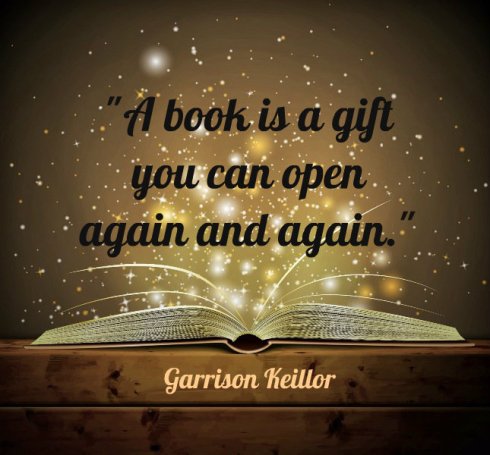
And since it’s almost 2015, here are sneak peeks from my upcoming titles to be released in August, September and October (talk about bada-bing, bada-boom-boom-BOOM!). Funny how these books were each signed within one year of each other, but they’re being released within one month of each other!
I THOUGHT THIS WAS A BEAR BOOK (Aladdin/S&S, August 2015)
illustrated by Benji Davies
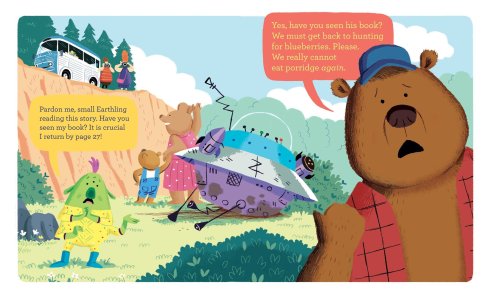
NORMAL NORMAN (Sterling, September 2015)
illustrated by S.Britt
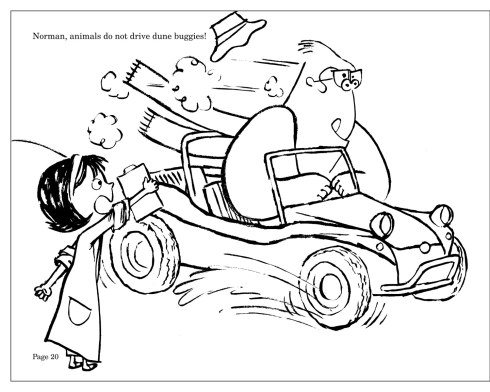
LITTLE RED GLIDING HOOD (Random House, October 2015)
illustrated by Troy Cummings
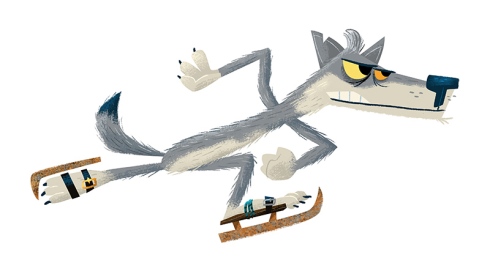
Once again, thanks for your patience with the PiBoIdMo winner announcements.
And may you and your family have a joyful holiday season!
(I hope you receive some really cool writerly gift!)


Oh, this doggie is persistent! He is so eager to know if he won!

Well, let me tell you if YOU won…
Timothy Young’s Prize Winners: One picture book each
JENNY SEIGER (The Angry Little Puffin)
ELIZABETH BROWN (I Hate Picture Books)
Carol Gordon Ekster’s Prize Winner: One signed copy of Before I Sleep
SHARON PUTNAM
Laura Zarrin’s Prize Winner: “Winter Dancing” print
ASHLEY BOHMER
I will be contacting you via email in the next few days to arrange delivery of your prizes.
Congratulations!
More prizes to come…


I know you’ve been waiting patiently…

So here are the Pre-PiBoIdMo Winners!
Matthew Winner’s Prize Winners (say that 10 times fast!): One picture book each
RITA ANTOINETTE BORG
KAREN CALLOWAY
Margie Myers-Culver’s Prize Winners: One picture book each
SHERRI JONES RIVERS
LAURIE SWINDLER
CAROL FEDEROFF
MIKE KARG
Lauri Meyers’ Prize Winner: PiBoIdMo Mug
PAM MILLER
Darshana Khiani’s Prize Winner: One picture book critique
SYDNEY O’NEILL
I will be contacting you via email in the next few days to arrange delivery of your prizes.
Congratulations!
More prizes to come…


by Deb Lund

“Amplify the Longing!” That was the first card I randomly pulled from my Fiction Magic card deck for writers on the first day of November. Jan O’Neil and I were hosting about a dozen writers for a PiBoIdMo and NaNoWriMo kickoff at the Diamond Knot Brewery next to the Whidbey Island ferry.

Good thing I pulled that card before everyone got there. It didn’t take long for Jan and I to discover the afternoon would be more of a social event than an idea-gathering one. Fortunately, using the Fiction Magic cards got us half way through our 30 ideas in record time so we could be social along with the rest of them!
When Tara asked me to write about using Fiction Magic for a Post-PiBoIdMo post, I said yes, because I always say yes to Tara’s challenges. In this case, though, I knew the cards would work well for generating picture book ideas, but following up on those ideas? My first thought was that it would be challenging. That’s good and bad.
It’s difficult for me to resist a challenge.
Fast forward to the last day of November, with my unfinished PiBoIdMo list. How could I write a Post-PiBoIdMo post if I didn’t complete the challenge myself? With my crazy schedule (and clothes-dryer mind), I hadn’t touched that list since our gathering. There’s nothing like a deadline to make a challenge even more exciting!
I pulled out my cards and completed my list in one short sitting. (Should I be admitting that to Tara?)
And then I heard from Jan:
“I had 30 ideas done in 28 days, with the last 11 ideas coming on day 28. That’s the day I was sitting in line for a ferry, pulled out your cards, and whipped out those last puppies.”

All that is great, but I still had the new challenge from Tara ahead of me.
I did say I like challenges, right?
I decided to keep going with the unknown (always a good thing to do when creating) and randomly drew a different Fiction Magic card to apply to each of the original ideas.
Remember the “Amplify the Longing” card? My PiBoIdMo lists in past years were a few words at the most. Not this year! The original idea from that card was:
Kid is never satisfied, wants more, more, more. Parents get run down, tired of trying to keep up with his demands, and when they can’t give any more, he gives them more and more love.
Jan revealed another similar experience:
“In the previous three Novembers, I finished all of the challenges by the skin of my teeth and came to understand that I am not one of those people for whom ideas come fully formed. Most of my ideas fit on one line of my journal paper. Later they may have notes written in the margins, but not at the time the idea first comes. This year, using the Fiction Magic Cards, my ideas are way more fleshed out. I mean, some even take six lines in my journal!”
So I held my breath, reminded myself that I love challenges, and drew a card as a follow-up to “Amplify the Longing.”
“Revolt!”
Yes! I could revolt and pick a different card, right? No? But the guidebook has creativity coaching tips following each craft suggestion! Couldn’t “Revolt” be a coaching tip?
Okay, okay…
My first thought was to have the parents go on a strike, but I didn’t want them to have any direct part in solving the problem, so I decided my main character needed to revolt. Maybe he’ll throw a tantrum until he’s all tired out, too. Then he can relate to how they feel and figure out that they all need love.
Don’t we all?
Here are a couple more examples of my PiBoIdMo ideas and how I used Fiction Magic cards to flesh them out:
“Speak the Unspeakable”
Original Idea: This little girl can only say no.
This little girl can only say no. When it’s time to go? No!
This little girl can never say yes. Clean up your mess? No!
This little girl can only say no. Would you like ice cream? No!
This little girl would like to say yes. Does she? No!
Can she still have ice cream? No!
The additional card I selected for this idea was “Take a Break.” I thought the girl could insist that she can’t say yes, but when she gets tired of all the no’s, of not getting all she wants, she stops talking instead of saying yes, and later, when she finally says yes, she saves face by saying the change was because her tongue needed a break. I also decided that I needed to take a break from all the “This little girl…” lines—and maybe a good long break from this idea!
Are you getting the idea that you have to come up with a lot of bad ideas in order to get a good one? Good! That’s one of the reasons Tara does all this work.
Okay, one more…

Baby learning to walk. It’s a risk for the baby, and the artwork could show the determination and obstacles to walking.
I thought this would be a story from the Baby’s point of view, but then I knew it had to be a sibling watching the baby learn to walk. The sibling, of course, is not happy about the baby getting all the attention until the baby chooses to walk to the sibling.
Well, there might be a little hope for that idea.
The card I chose to follow up on that one was “Provoke a Response.” That’s exactly what the baby does. Naturally, there would have been a response from the sibling, but because of the second card, I’ll make sure it’s big enough. And maybe the baby will even say the sibling’s name as the first word. Hmmm… And that means I will work in a little bit at the beginning about how the baby “can’t even talk” and just “makes noise.”
See how this works? Fiction Magic isn’t magic. It just feels that way because it triggers new ways of seeing and deepens the concept and plot by combining ideas to create what Tara and I call “High Concept Picture Books.”
Will I work on any of these stories? Maybe. Will any of them be published? It doesn’t matter. It’s all practice. You have to mine a lot of rock to get at the gems.
Keep adding to your ideas, keep writing badly (you have to reach your quota!), and go where your magic leads you.

Deb Lund may be best known as the author of All Aboard the Dinotrain and other picture books, but she has taught writing (the focus of her master’s project) to teachers and writers of all ages for 25 years. Deb is also a creativity coach whose mission is to get everyone claiming their creativity. Visit her at DebLund.com and follow her on Twitter @DebLund.

Fiction Magic: Card Tricks & Tips for Writers is a 3.5” x 5” boxed set of 54 cards with a 60-page guidebook. Fiction Magic card “tricks” help writers raise the stakes in their writing with phrases like “Alienate an Ally” and “Remove the Moral Compass.” The guidebook provides possible interpretations for each of the 54 cards, followed by creativity coaching “tips” to help writers apply the cards’ messages to their writing lives. It’s like having two decks in one!
For a limited time, Fiction Magic is 50% off.
***THIS POST CONCLUDES PIBOIDMO! THANK YOU FOR PARTICIPATING AND GOOD LUCK WITH YOUR IDEAS! PRIZES WILL BE ANNOUNCED ALL WEEK, SO STAY TUNED!***


It’s the moment you’ve all been anticipating!
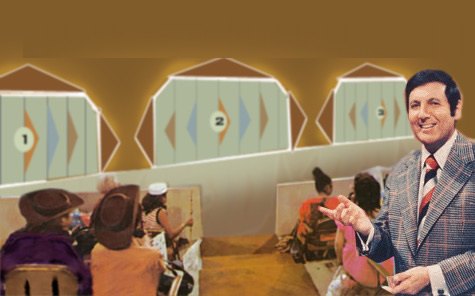
Monty, show ‘em what’s behind door number one!

Why, good golly, it’s a Broyhill bedroom set!
What better place to read a picture book, right?
OK, sorry, just kidding. That is not your grand prize.
You know what the grand prizes are all about—you win a review of your best five PiBoIdMo ideas by a picture book agent! So much better than a stained oak nightstand!
How were the PiBoIdMo 2014 GRAND PRIZE WINNERS selected?
Every participant who signed the PiBoIdMo Winner’s Pledge was assigned a number based upon the order in which they commented. I then used Random.org to generate 10 random numbers. The numbers were checked to their corresponding name, then I ensured that name was on the PiBoIdMo registration post. If the name had been registered, then I double checked to make sure they had not commented on the winner’s pledge multiple times (thus giving them extra chances to win). If all checked out, the winner was verified. (And they all checked out!)
Without further ado, here they are! Please congratulate them!
SANTIAGO CASARES
LOUANN BROWN
ALEXANDRA KOTANKO
AMANDA SMITH
CHERYL MICHAEL
HOLLY MCLAUGHLIN
NICOLE POPEL
ANGIE JONES
LAURA WYNKOOP
TERESA DAFFERN
I will pair each of you with a PiBoIdMo agent and contact you via email.
If you are a grand prize winner, please read the following carefully:
You will have one week (from the date of my email) to contact your agent with your FIVE best ideas. I suggest you flesh them out into a paragraph each, like an elevator pitch. Something short and snappy. The agent will then provide feedback on which idea(s) may be the best to pursue as manuscripts. The agent may provide short and sweet feedback like a simple “Go for it!” or more lengthy feedback providing suggestions. I don’t know what’s in store for you–but there’s one thing for certain–their feedback will help you determine what to begin writing!
Thank you all for participating this year!
Remember there are PLENTY more prizes to come throughout this week—everything you saw during the event plus even a few more!
Maybe even a Broyhill living room!



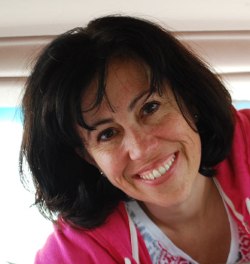 by Laura Zarrin
by Laura Zarrin
Picture Book Idea Month is over. You have ideas waiting to be developed. Now what?
As a kid and all the way through college, writing came easily. Essays or essay questions? No problem. I loved to really pad those answers. Fast forward to now and that ease is completely gone. Sometimes I have no words, not even a decent name for the file I’m writing in. What happened to the free flow of words? Maybe they shriveled up and died from lack of use. Maybe I spend so much time drawing that the words have gone to sleep? I’m sure it’s a lot of things, but one thing that’s different is that while the more words the better method worked in school, it’s the wrong approach to writing picture books where brevity rules. As a mom and an illustrator, I appreciate brevity. Short books were my favorite since I’d have to read the same book over and over and over again.
As an illustrator, I approach my stories through pictures first. I ‘see’ them before I write them. I’ll sketch out the character or a scene and see where it leads. Sometimes I’ll be so inspired that I’ll write a quick first draft. It’ll be horrible, but that’s ok. The point is to get something written out. To begin. I can always go back and edit it or completely rewrite it. Mostly, I have to let the ideas marinate in my head for awhile, sometimes years, to figure out what the real story is. I turn it around, hold it up to the light, add and subtract characters, try various what ifs, and grill it with questions until it feels solid. I really wish I could just snap my fingers to create the book dummies, but it just doesn’t work that way. Even though picture books are ‘simple’, they’re anything but easy. It’s like saying it’s so easy to draw in a simple and childlike way when it’s anything but. It takes a ton of work to get to the point where one can pull off ‘childlike’ effectively. One has to have a solid grasp of anatomy, technique and design to make it work. The same can be said of writing. It takes some serious chops to write a story in it’s simplest form.




I wish I could give you a formula. Heck, I wish I could give me a formula, but as it stands, my formula is to scribble, sketch, make lists, make notes, outline, research, work on character design, write then delete, draw, and draw, and draw, cry, give up, try again, and eventually there’s this thing that actually becomes a story.
My suggestion to you is to just begin. That’s often the hardest part of any project. Draw your character or a scene that’s calling out to you. Write the character’s bio, outline your plot or write a synopsis. Whatever feels like the easiest entry point to begin. Good luck!

Illustrator of fourteen children’s books, Laura Zarrin, is branching out into writing them too. Laura’s warm and whimsical collage paintings have graced many products from stickers to bulletin boards to books. Her paintings are created in layers traditionally, then scanned, assembled, and enhanced in Photoshop and Manga Studio, so that the art can be reformatted for a variety of products and apps.
Laura’s Bachelor’s degree in Graphic Design and Illustration paired with her years of experience working as a designer and art director have given her many great opportunities to work with other designers, editors, sales people, and marketing in collaboration on many projects, from inception to completion. Fluent in the Adobe Creative Suite.
She lives and works in San Jose, Ca with her husband and two endlessly creative sons.
Visit her at LauraZarrin.com and follow her on Twitter @LauraZarrin. She blogs at Creative Whimsies and Simply Messing About.

Laura is giving away an 8×10 print of “Winter Dancing”.

This prize will be given away at the conclusion of PiBoIdMo. You are eligible for this prize if:
- You have registered for PiBoIdMo.
- You have commented ONCE ONLY on today’s post.
- You have completed the PiBoIdMo challenge.
Good luck, everyone!


 by Elizabeth O. Dulemba
by Elizabeth O. Dulemba
Sometimes I’ll get an idea for a picture book that I know is a winner! I scramble to write the key lines, the story’s premise, its arc…and then, something goes wrong. There’s a piece that’s missing, or elements that aren’t quite gelling. Maybe the ending isn’t satisfying enough. But, that doesn’t mean it’s a bad idea. So I save it.
I have a “Pre-pubbed Books” file in which I keep folders brimming with ideas. In these folders I’ll put sketches, various story versions, images of books I think might be similar, or reference photos that fit the story. You name it.
Of course, not all ideas come in whole. Some arrive as only a title or simple phrase. For those I have an “Other ideas” file. Inside are the years: 2004—2014. In those folders, I just save Word documents. Sometimes it can be one phrase or a character idea, but it was something that made my brain light up, so I keep it too.
And then there’s my dummies wall. Sometimes a story is so strong, I’m dying to illustrate it. Maybe I just do character sketches, or a few spreads. Sometimes I sketch out the entire dummy and even take a few pieces to final. This can lead to a lot of paperwork with no place to put it. This is when bulldog clips become my friends. I collect everything together, clip it, and hang it on the wall on a pushpin.

I’ll often sit back to look at these works-in-progress hanging on my wall and wonder if I have a new seed or tweak that might help them along.
Some of these folders, documents and dummies have been around for a while, but that doesn’t mean they’re dead. Sometimes it takes combining ideas, or swiping a phrase from one story to make another story stronger. So, I keep them organized so that I can mine them whenever I want to.

I also firmly believe some of them are ready to be published, but for whatever reason, the publishing world isn’t ready for them yet. Because of trends, word counts, a hit book that is too similar… whatever the reason, I’ll let them wait until trends circle back around and they become relevant again.
The irony is, with all these attempts at creating stories I’ve trained my storytelling muscles. I tell kids that writing is like lifting weights. The more bicep curls you do, the stronger you get. The more you write, the more those writerly muscles seem to know what to do. I’ve written so many picture book manuscripts that now, when I write, it seems stories come out of me in just the right word count and just the right number of page breaks. I’ve trained my brain to the structure of picture books.
But that still doesn’t mean they all work, hence, my folders and files and dummy wall. Sometimes a story will sit for a day, sometimes for years before I figure out the key that unlocks whatever was wrong and makes the story work. But I’ve learned to be patient with myself. Some stories, even the simplest (seeming) ones, need more time.
So, if you know deep down inside that your story isn’t there yet (don’t ignore that little voice), put the manuscript aside. Put it somewhere where you won’t forget about it, and let your brain work on it—while you sleep, or garden, or take a shower, or just get on with life. It doesn’t have to be perfect straight out of the box, few stories are.

I call it putting the clay on the wheel. You’ve got the idea down, you know its missing or lacking something. So knead it in the back of your mind, for however long it takes, until you get your story just right. You’ll know when.
And then, then you send it off to a publisher or to your agent. And maybe that manuscript that you struggled over, that you let simmer, will finally be so perfect, so right, they will buy it and publish it and you will get to share it with the world!

Elizabeth O. Dulemba is an award-winning children’s book author/illustrator with two-dozen titles to her credit. She is a Board Member for the Georgia Center for the Book, and Visiting Associate Professor at Hollins University in the MFA in Children’s Book Writing and Illustrating program. Her latest picture books are a series of books for Children’s Healthcare of Atlanta and LULA’S BREW. Elizabeth gives away free coloring pages and hosts interviews, guest posts, and giveaways on her website each week. Sign up for her weekly newsletter and learn more at Dulemba.com.




 by Carol Gordon Ekster
by Carol Gordon Ekster
Whew! You finished your 30 PiBoIdMo ideas.
Now what?
Stare at them. Admire them! Write them all at once?
Good luck with that! One of the great things about being a writer is that you are your own boss and you can do as you like!
Don’t tell anyone…I cheat a bit with this PiBoIdMo concept. For me it’s morePiBoIdMoS. The minute I hear the first whisper that PiBoIdMo is coming, whether through Tara’s tweets, Facebook page, or her blog, I start a document on my desk: “PIBOIDMO 2014.”
Yes, technically I start before November 1st, and I keep going! It gets me on a roll…deeper listening, inspiration from all the posts, and a mind more opened to all those picture book possibilities. Every new idea that follows will get listed on that sheet, maybe through February, maybe until I open the “PIBOIDMO 2015” document. Then when I’m finished working on a manuscript, revision, or submission and I’m ready to start a new story, I’ll glance through those ideas. (I have a document for ’12 and ’13 that I still revisit.)
I’ve never deleted any of the less than fabulous story concepts, but I have highlighted a few that I thought had potential. Sometimes, right under a numbered idea, I start the story’s beginning. It just flows from my finger tips. I don’t have an organized plan. I go with my gut.
When I start a separate document for a numbered idea, I know I’m serious about it. I never forced the beginning of one of those ideas. I waited until the idea grabbed me and said, “It’s time. Start the draft!” I have to feel it. I’ve developed quite a few of those ideas from the past years into manuscripts. I drafted, rewrote, revised and brought them to critique groups. None of those stories have yet to be acquired. But I have faith that some will…when the time is right. Though I have gotten “the call” on one…but no contract in hand as yet.
This year there was mention of PiBoIdMo kick-off parties. A fabulous gathering spot for writers, The Writer’s Loft, had one. And though I couldn’t make it, I was there in spirit. But I think we also need AFTER-PARTIES, as a way to celebrate all that thinking, all those brilliant ideas. Perhaps gather other PiBoIdMo’ers and plan a few peer critique sit-ins—where large groups gather and break into smaller groups to share their manuscripts. (Of course, bring snacks and allow time for socializing, too!)
If you can’t do that, find another way to get other writers’ eyes on your story. This step is imperative. Once those critiques are in, it is time to polish and revise and incorporate all that you have learned about craft and about picture books. This is where it counts. This is where we water and love those seeds of ideas until they sprout into the best possible work we can create. For every story idea you develop into a manuscript, make a “sentence” document for that title. This way you can brainstorm many different ways to word each thought until you get the perfect line up of words, until each sentence sings. Don’t be lazy. Get it right. Someday, you’ll be touching a life with that story. Don’t settle for less than the best you are capable of.
Before you know it, we’ll be preparing for “PIBOIDMO 2015”. Don’t let all this creativity be forgotten. Continue to glance back at your ideas. You never know when that gem of a manuscript is ready to emerge and start its route to publication.

Carol Gordon Ekster was a passionate elementary school teacher for 35 years. Her first book, Where Am I Sleeping Tonight? — A Story of Divorce, Boulden Publishing, 2008, was an About.com Readers’ Choice 2012 finalist for Best Children’s Book for Single Parents. “The Library Is The Perfect Place”, was in Library Sparks magazine, 2010. A picture book, Ruth The Sleuth and The Messy Room, on Character Publishing’s debut list, 2011, was awarded the Children’s Literary Classics Seal of Approval. Before I Sleep: I Say Thank You, comes out January 1, 2015 with Pauline Books & Media. Her first e-book, Hip Hopping Books, will be out with Schoolwide Inc.’s digital library, winter 2015. Retired from teaching, Carol now spends time in critique groups, doing exercise and yoga, and working on her books. She’s grateful that her writing allows her to continue communicating with children. Find out more at CarolGordonEkster.com and follow her on Twitter @cekster.

Carol is giving away a signed copy of BEFORE I SLEEP!
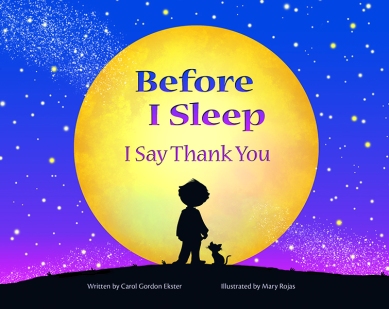
This prize will be given away at the conclusion of PiBoIdMo. You are eligible for this prize if:
- You have registered for PiBoIdMo.
- You have commented ONCE ONLY on today’s post.
- You have completed the PiBoIdMo challenge.
Good luck, everyone!


♩♪♫♬ Oh the weather outside is frightful… ♩♪♫♬
…and so is my voice so you really don’t wanna hear me sing!
But what you do want is snazzy stuff for your favorite writer friends, maybe even for yourself. So I’ve combed the Internet for some unique and writerly gadgets, gizmos and gifties you’ll be proud to give or own this holiday season. Grab a cuppa cocoa, shop and share!
.
1. USB Warming Things (Mug warmer, foot warmer and writing gloves)
If you’re attached to your computer all day, why not take it literally by plugging in and warming up? Keep your coffee hot, your tootsies warm and your fingers flying across the keyboard.

Hot Cookie USB Cup Warmer available from GadgetsandGear.com.

Sea-son to Snuggle Narwhal Foot Warmers available from ModCloth.com.

USB Heated Writing Gloves available from KlearGear.com.
.
2. Maria Cristina Bellucci Jewelry
Do you want to make a statement? How about “I love to write (and live) in color”?
Maria Cristina Bellucci hand-carves colored pencils into the most unique and fun jewelry pieces you’ve ever seen.



Colored pencil jewelry available from mcbjewellery.bigcartel.com.
.
3. Litographs Shirt
The best book you’ve ever worn. Litographs t-shirts are comprised from the text of your favorite classics. Yes, those are green words!

The Secret Garden tee available from Litographs.com.
.
4. My Bookstore: Writers Celebrate Their Favorite Places to Browse, Read, and Shop
Before you take out a second mortgage, let me clarify: I’m not suggesting you buy a bookstore, but rather a book. Eighty-four authors tell tales of their favorite independent bookstores–with witty, heartfelt and inspiring words.

My Bookstore, available at your favorite indie.
.
5. Lumio Folding Booklamp
When bibliophiles open a book, they get turned on. Well, open this book and it turns itself on.



Lumio [almost] available from HelloLumio.com.
.
6. “Writer” Bookends
What better place to display your growing collection of authored titles?
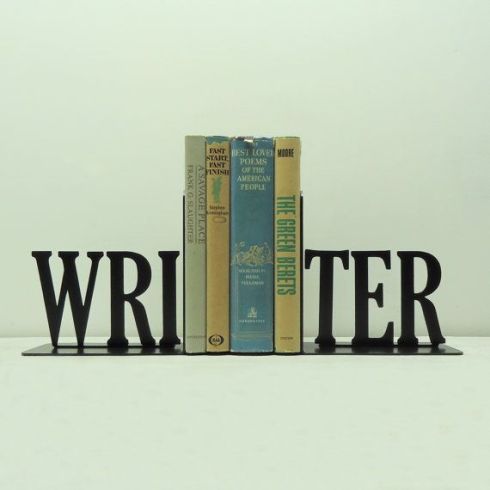
“Writer” bookends available from Etsy seller KnobCreekMetalArts. (Thanks for the suggestion, although I cannot recall who sent it to me. Reveal yourself, please!)
.
7. Speech Bubble Bookends
Yes, another pair of bookends. But they’re worth it. You can make them say whatever you please!

Speech bubble bookends available from Gadetsandgear.com.
.
8. Library Due Date Card Tie
This is for the guys, if you want to be “checked out”.

Silk-screened library due date card tie available from Etsy seller Cyberoptix.
.
9. BookBook for MacBook
A sophisticated, leather-bound book cover for your more modern “book”.

BookBook available from twelvesouth.com. (Thanks for the suggestion, Mary Zisk.)
.
10. Boogie Board Sync
No, we’re not catching waves. We’re catching ideas! Ever lose those scraps of paper onto which you’ve scribbled what MUST be a NY TIMES BESTSELLER idea? Well, fret no more. Capture your thoughts on the Boogie Board and then sync it up to your smartphone or computer.

Boogie Board Sync available from myboogieboard.com.
.
11. FlipNote by Wellspring
For those who prefer the tried-and-true pad and paper, there’s FlipNotes. Stick it in your purse or pocket and never be without a place to store your thoughts.

FlipNote available from WellSpring.com.
.
12. Old Books Scented Candle
Give the gift that keeps on smelling (like a used bookstore)!

Old Books scented candle available from Etsy seller Frostbeard Studio.
.
Well, this is so much fun I could go on for ages. But alas, I must pause to get back to PiBoIdMo activities.
However, you can keep shopping via my Pinterest board, Things Writers Like. Hundreds more goodies there!

Enjoy and Happy Holidays, writers!


by Laura Gehl
In November, there are no bad ideas. You write down every single thought that comes into your brain. And that’s good. But then…December comes. And now there are bad ideas. Bad ideas that you need to separate out from your other ideas. So you can focus on pursuing your promising ideas without all the clutter holding you back.
To help categorize your PiBoIdMo ideas, I’ve created this handy diagram, adapted from What If? by Randall Monroe.

Start by putting all your ideas quickly into the “Possibly Good” or “Possibly Bad” boxes. Don’t think too hard. Most of your ideas will go into Possibly Good. But some will go into Possibly Bad.

Now it’s time to start moving things around.
- Type your title ideas into Amazon. Does one of your brilliant, witty titles already exist, or something too similar? If so, boot that idea out of the “Possibly Good” box. No reason to start with strikes against you. This happened to me recently with my “Possibly Good” idea of Jellyfish Loves Peanut Butter. Turned out there are several Peanut Butter and Jellyfish books out there already.

- Take a look at your “Possibly Bad” ideas. Some of them will go straight into “Probably Bad.”

Other “Possibly Bad” ideas might go into “Probably Bad” and then get resuscitated later, with a little twist.

- When you read through your “Possibly Good” ideas, there will probably be a few ideas that make you smile just to think about. Make your brain buzz like you drank a cup of coffee. Make you itch to go start writing right this second. Those ideas are the ones you want to move on over to the “Probably Good” box right away.

Once you identify some “Probably Good” ideas to start working on, keep your PostPiBo diagram handy. When you get stuck, pick out a “Probably Bad” idea and…just for fun…write a few lines of that story. Afterward, your brain may be a little bit more ready to focus. Or maybe you’ll discover a way to twist the bunny-stabbing unicorn into a “Possibly Good” idea….after all, it’s never been done.

Laura Gehl is the author of One Big Pair of Underwear, illustrated by Tom Lichtenheld, which released in September. She is also the author of four upcoming picture books: And Then Another Sheep Turned Up; Hare and Tortoise Race Across Israel; Peep and Egg: I’m Not Hatching; and Peep and Egg: I’m Not Trick or Treating. Laura is also the author of 57,982 Possibly Good Ideas, and 26, 444 Probably Bad Ideas. She lives with her husband and four children in Chevy Chase, Maryland. Visit Laura online at www.lauragehl.com and http://www.facebook.com/AuthorLauraGehl.




 by Michele Wells
by Michele Wells
Creating a digital version of your picture book can be exciting. Or daunting. Or both. The learning curve in creating apps and eBooks was once so steep that most picture book authors and illustrators had no choice but to leave the process of creating apps and eBooks to the publisher. And depending on resources, budget, marketing allocations, and the like, a digital version might not have been an endeavor the publisher was willing—or able—to take on.
In the past few years, however, children’s books have exploded digitally, and new, inexpensive, and intuitive platforms have emerged to allow for easy(ish) creation of enhanced eBooks and apps. The playing field has leveled; it is now possible for authors and illustrators to create digital adaptations of their picture books with only a small initial investment and very little technical know-how. It has also become easier to distribute content on the iPad, Android, Nook, Kindle, and other platforms. So, since a great story deserves to be told and retold, it makes sense for authors and illustrators to consider adapting their picture books to be enjoyed on various devices across all types of media.

Image via purplecarrotbooks.com
But what makes a good digital version? It’s not enough to simply add tappable animal sounds to a picture book about a farm and call it a day. The best interactivity moves the story along; it does not distract the reader, or in any other way detract from it. Taking the reader’s attention out of the moment to play a mindless game isn’t exactly the best way to engage with a story, much less to promote literacy and encourage reluctant readers to get into the habit of reading.
So where should you start? To make the digital experience as satisfying as the physical one, you need to think about how the reader will be engaging with the story on a device. Therefore, the interactivity you choose to include should enhance the world you’ve built and the journeys of your characters. In fact, if done well, the interactivity should be experienced as a natural extension of the story. This means that each key moment, each plot point, should be examined for ways in which the user can participate in the story.
You should also devote some time to thinking about the specific ways in which your readers will relate to the telling of the story itself. If your picture book is plot-oriented, then an app made up of quick, adventure-based activities set at specific story beats might be the way to go. If you have a rhyming story, an eBook with a “read-along” feature might make more sense. Basically, as the content creator, you need to decide the specific what and why of the interactivity to ensure that the experience you’re providing digitally is organic to the world of your book.

Image via designboom.com
Here are some things to keep in mind when creating a digital version of your picture book:
- Look for moments of interactivity that naturally present themselves within the story. Let’s say there is moment in which your protagonist is crossing a river. In this case, it might make sense to invite the user to participate in an activity that helps guide the protagonist to safety.
- Since picture books appeal to both parents and children, consider including activities that resonate with both demographics. The best interactive features are collaborative, with engaging interactivity for adults and kids.
- Think about what types of content would be a true value-add from a digital perspective. It might make sense to include a video, or a tappable resource that allows readers to learn more about your subject than is possible in book form.
We all know that interactive stories are a great way to improve literacy, as children who are reluctant to sit still for traditional books are sometimes drawn into the “gamified” experience of interacting with a picture book on a device. But it’s our responsibility as content creators to ensure that the digital experience provides a rich, fully realized experience rather than just flashy, “keep ‘em busy” activities to allow readers to truly participate in the world you’ve created, and keep them coming back for more.

Michele R. Wells is an editor and writer with two decades of experience in multimedia and print publishing. An expert in conceptualizing and developing content, she has edited illustrated books for DK Publishing, lifestyle nonfiction for Penguin, and business self-help for McGraw-Hill, as well as educational content for Pearson, The Princeton Review, and others. She currently manages the digital editorial department at one of the world’s largest entertainment companies, where she has written scripts for award-winning apps and interactive products. The author of several books for children and young adults, she volunteers for literacy organizations, and was the founding chairperson of First Book-Brooklyn. She now lives in Los Angeles. Follow her on Twitter at @michelewells.


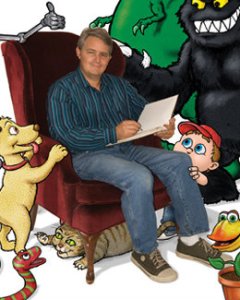 by Timothy Young
by Timothy Young
First, congratulations on completing PiBoIdMo, getting all 30 of your great ideas down on paper. Or, congratulations on attempting PiBoIdMo, but only finding the time to get about 20 picture book ideas down on paper. Or, good try, you only found the time to get 5 or so picture book ideas down on paper because you’re really busy this time of year (heck, don’t kid yourself, you’re busy all year-round) but you feel like you’ve got 2 or 3 really good ideas you want to pursue. I, as usual, fall into the last group. It’s not that I lack good ideas, I just can’t get organized to write them all down on a schedule. Plus I have the added excuse of spending this November finishing my next book.
So now it’s December 3rd, now it’s time to take those 2 or 3 good ideas and start turning them into books. So let’s sit down and start writing, as soon as you go pick out a tree and decorate the house for the holidays. OK, that’s out of the way, let’s start writing, as soon a you finish that job you started in mid-November and the deadline is fast approaching. OK, that’s done, now it’s getting close to Christmas and you’ve got so many functions and last minute shopping and then it’s New Year’s Eve and I promise I’ll get around to writing as soon as the new year starts. Well, right after I do my taxes, that is. What do you mean Happy Valentines Day?! Where is the time going!

So here’s the issue, I don’t know about you, but I’m really busy. I work for myself as a graphic designer and freelance illustrator. I have a number of clients who are very demanding (especially that one who always calls at 4:30 with some emergency that requires another 4 hours of work). Add to that family stuff and general household needs, who has time to write?

So here are some secrets to finding all the time you need to write:
- Inherit loads of money so you don’t have to have a job. This also works if you win the lottery.
- Marry someone who is really wealthy so that you can have servants to take care of all the small stuff like raising the kids. This frees up a lot time.
- Become really famous for something else, like acting in movies or singing great songs, then publishers will pay you lots of money to write a book. Even becoming infamous can get you a book deal.

Sorry, I didn’t mean to make it sound hopeless, it’s not. We write because we have to, because we are passionate about it. Don’t ask me how I found the time to get 5 picture books out in 6 years, 4 of which are with a publisher so small they don’t pay an advance*, and I’m the illustrator as well, so I really have to work some late nights. Basically I’ve found that you just have to make the time. Find an hour here and an hour there. Get up a few hours early on the weekends and leave the dishes in the sink until later. If you are sitting in the car on a long trip, write in your head or speak it into your iPhone.
You found the time to do PiBoIdMo, you’ll find the time to write your books. You will, because you want to, you need to…because you have to do it, for you.
*Don’t get me wrong, I love Schiffer Publishing, they’re an independent, family-run publisher that has been around since the early seventies, they pay good royalties and they do an excellent job producing my books and distributing them.

Timothy Young has had a lot of fun jobs; he’s been an animator, puppet maker, toy designer, sculptor, art director, illustrator and graphic designer. Tim has designed for Pee-Wee’s Playhouse, the Muppets, Disney, the Simpsons and Universal Studios. Now he is the author/illustrator of 5 published picture books including I Hate Picture Books! and his latest, The Angry Little Puffin. He lives with his family on the Eastern Shore of Maryland.

Visit Tim’s website at creaturesandcharacters.com. Friend him on Facebook and follow him on Twitter @TimSYoung.

Tim is giving away two books–a signed copy of THE ANGRY LITTLE PUFFIN and a signed copy of I HATE PICTURE BOOKS!
These prizes will be given away at the conclusion of PiBoIdMo. You are eligible for these prizes if:
- You have registered for PiBoIdMo.
- You have commented ONCE ONLY on today’s post.
- You have completed the PiBoIdMo challenge. (You will have to sign the PiBoIdMo Pledge at the end of the event.)
Good luck, everyone!



By:
Tara Lazar,
on 12/2/2014
Blog:
Tara Lazar
(
Login to Add to MyJacketFlap)
JacketFlap tags:
Picture Books,
Cece Bell,
Bee-Wigged,
Bug Patrol,
El Deafo,
PiBoIdMo 2014,
Crankee Doodle,
Itty Bitty,
Rabbit and Robot,
Add a tag
 by Cece Bell
by Cece Bell
Several years ago I was at a really low point in my career as a children’s book author and illustrator. None of my published books seemed to be doing all that well, and every new book I submitted seemed to get rejected. I was stuck. My writing came to a standstill. I didn’t even want to draw anymore! Good grief!
Eventually, I got off my pity pot by realizing that I didn’t have to get a publisher interested in my stories and drawings in order to work. I just needed to start working again—for FUN, not profit. So I decided to hire myself. Here was the assignment: Ask friends and family for adjectives and names of animals. Write adjectives on separate slips of paper. Fold them up and put them in a cup. Write names of animals on other separate slips of paper. Fold them up and put them in a different cup.
Now for the good part: Each day, for over one hundred days (and I didn’t skip any days, not even weekends), I selected a slip of paper from the adjective cup, and I selected a slip of paper from the animal cup. What I selected was what I had to draw—in no more than two hours. I couldn’t put anything back and hope to get a “better” combination—all combinations were good. The more challenging, the better!
I ended up with pairings like “victorious chinchilla” and “lost ocelot.” “Glittery manatee” and “theiving sloth.” “Bashful anteater” and “uncomfortable ostrich.” “Maniacal anemone!” It was great fun to illustrate all these animals I didn’t normally draw; it was especially fun to come up with stories (not written, but implied in the illustration) for why the chinchilla was victorious, for why the ostrich was uncomfortable. And what would the sloth steal?

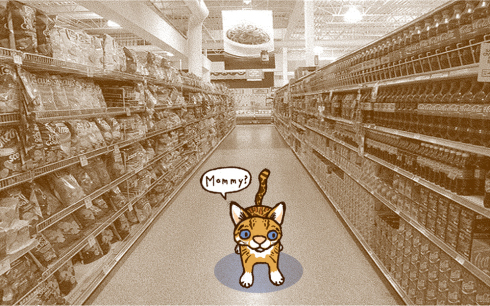
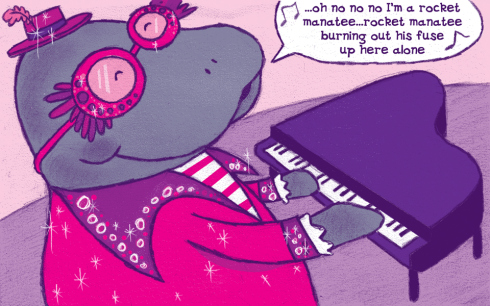

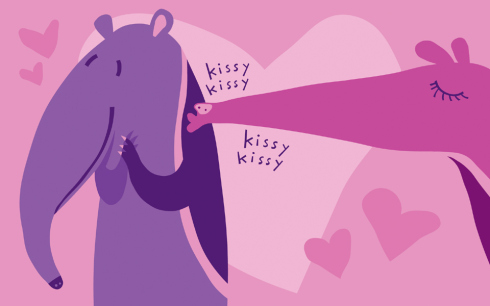

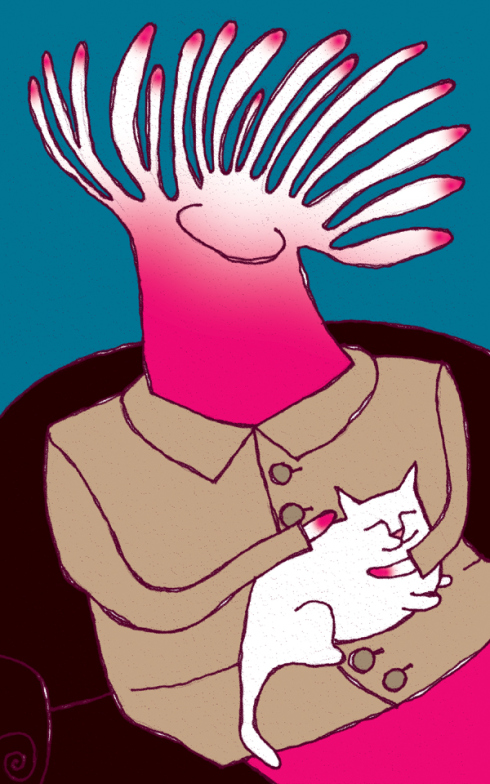
I was a cheap boss. I didn’t pay myself a cent. But the rewards of my little project were copious. My brain loosened up. I learned some new illustration techniques. I began to love being an illustrator again. I GOT OUT OF THAT FUNK. And guess what? When I decided to submit “mustachioed fly” to my agent to turn into postcards, I got hired to illustrate Diane Mortensen’s picture book Bug Patrol for Clarion. This job led to a relationship with Clarion that made my picture book with Tom Angleberger (Crankee Doodle) possible, and then that helped me loosen up to do El Deafo. Now I’ve got more work than I can shake a stick at!
My little project was focused on illustration—but it could work for writing, too. TOTALLY!
So, my humble two cents (I happen to have those cents because I didn’t pay myself earlier, remember?) is that if you pursue this line of work—or any line of work—do so because you love it. Try not to lose sight of that love. And hopefully, that love, plus a lot of hard work and little bit of luck, will get you where you want to be.

 Cece Bell lives in an old church with her husband, author Tom Angleberger, and she works right next door in a new-ish barn. El Deafo, her first graphic novel, is a slightly fictionalized memoir about her childhood, her hearing loss, her first crush, and her quest for a true friend. She has written and illustrated other books for children, including the Geisel Honor book Rabbit & Robot: The Sleepover; Itty Bitty; Bee-Wigged; and the Sock Monkey series. You can read more about her at www.cecebell.com. Follow along on Twitter @cecebellbooks.
Cece Bell lives in an old church with her husband, author Tom Angleberger, and she works right next door in a new-ish barn. El Deafo, her first graphic novel, is a slightly fictionalized memoir about her childhood, her hearing loss, her first crush, and her quest for a true friend. She has written and illustrated other books for children, including the Geisel Honor book Rabbit & Robot: The Sleepover; Itty Bitty; Bee-Wigged; and the Sock Monkey series. You can read more about her at www.cecebell.com. Follow along on Twitter @cecebellbooks.


So do you have 30 ideas?
YOU DO???

You can qualify for one of our AMAZING PiBoIdMo prizes just by taking the following pledge. Put your right hand on a picture book and repeat after me:
I do solemnly swear that I have faithfully executed
the PiBoIdMo 30-ideas-in-30-days challenge,
and will, to the best of my ability,
parlay my ideas into picture book manuscripts.
Now I’m not saying all 30 ideas have to be good. Some may just be titles, some may be character quirks. Some may be problems and some may create problems when you sit down to write. Some may be high-concept and some barely a concept. But…they’re yours, all yours! Give them a big, fat, juicy smacker! SMOOCH!
You have until December 4th at 11:59:59PM EST to sign the pledge by leaving a comment WITH YOUR FULL NAME on this post. PLEASE COMMENT ONLY ONCE.
The name you left on the registration post and the name you leave on this winner’s pledge SHOULD MATCH.
Again, please COMMENT ONLY ONCE. If you made a mistake, contact me instead of leaving a second comment.
Remember, this is an honor system pledge. You don’t have to send in your ideas to prove you’ve got 30 of them. If you say so, I’ll believe you! Honestly, it’s that simple. (Wouldn’t it be nice if real life were that straightforward.)
If your name appears on both the registration post AND this winner’s pledge, you’ll be entered into the grand prize drawing: feedback on your best 5 ideas from a literary agent. There are TEN grand prizes! Check out all the agents here.
So what should you do now? Start fleshing out your best ideas! Write them as elevator pitches. Get ready because YOU might be a CHOSEN ONE.
Other prizes include picture books, manuscript critiques, art prints—all the stuff you saw during the month. All winners will be randomly selected by Random.org and announced NEXT WEEK.
And guess what, PiBoIdMo doesn’t end here! From today through December 8th, stop in for Post-PiBo, which offers daily posts about organizing and prioritizing your ideas.
Plus—you can claim your first prize now: a winner badge for your website, blog or social media site, designed by Vin Vogel. You can make it larger or smaller to fit anywhere. And if you want it on a mug, don’t forget to stop by the PiBoIdMo shop where every purchase benefits Reading is Fundamental (RIF).

Congratulate yourself on a job well done, PiBoIdMo’er. Take yourself out to brunch. Buy a new infinity scarf. Browse a bookstore. Pat your head and rub your tummy. Do what you want, you deserve it.
Go ahead, sign below and cross the finish line!
And remember, stay tuned for Post-PiBo!


 ***To everyone who completed the PiBoIdMo Challenge, the Pledge for you to sign is coming later today. In the meantime, enjoy our first Post-PiBo guest blog with a very talented illustrator!***
***To everyone who completed the PiBoIdMo Challenge, the Pledge for you to sign is coming later today. In the meantime, enjoy our first Post-PiBo guest blog with a very talented illustrator!***
by Vanessa Brantley-Newton
When I was going to school, I attended a community school that had been created by the parents and local writers, artist, musicians, and poets. It was a special school because we could not go to white schools. We had some of the best teachers ever! One day, I met this wonderful teacher named Miss Russell. Miss Russell had the biggest, orangest afro I had ever seen in my whole entire life. It looked like a cloud. She wore the shortest dresses and the coolest shoes. I loved Miss Russell. Once she set me on her lap and shared a beautiful book that has stayed with me all these years. It was about a young boy who wore a red snow suit and lived in the hood as far as I was concerned, LOL! The thing that stood out about this boy was that he was brown just like me!
He was beautiful!! His mom and dad looked just like my parents. Even the wallpaper looked like the wallpaper in my own house. I was excited and thrilled. Surely the person was who created this book must have been watching me from his studio window. The book left me feeling some kind of way. It conveyed all my feelings and thoughts through its beautiful, colorful pictures and collage. I couldn’t remember all the words to the story, for you see I am dyslexic. There was nobody who really understood what that was. The words didn’t make sense to me but the pictures told me the story.

Everybody is now talking about diversity in children’s books. In 1963 there weren’t many books that had a black children as a main character, and when they were drawn in children’s books of old, black people were drawn very cruelly and just plain ugly. The book moved me so because it would be the first time I would see a black child that looked like me, dressed like me…might have even been me, LOL.
I loved Peter—he was my little brother in my head. Peter was beautifully illustrated and I related to his story because I had experienced the same thing. Countless other children experienced the same thing. Many years would pass and I would end up in a Barnes and Noble looking for picture books to inspire me as I began to illustrate children’s books myself. I came across “The Snowy Day”.

Now as I told you, I am dyslexic. Reading for me sometimes can be a struggle. The words seem to dance on the page. Numbers seem to move and float around. I push myself constantly to read out loud, and while I make it look effortless and fun, it is a struggle for me still. I took “The Snowy Day” and sat on the floor of B&N and I read it through tears. Every wonderful and magnificent word.

Finally, words and pictures came together. Comforting memories from the first time that the book was read to me spilled over like warm beach waves. I looked for books written and illustrated by Ezra Jack Keats. I began to do my own study on his work. I copied the man. I wanted to somehow do for other children what this awesome man had done for me. Ezra Jack Keats made me feel so special because he thought that I should have been in a children’s book all along. I wasn’t an afterthought!

It is important that not only Black, White, Chinese or Indian children be seen in picture books, but that all children see themselves in picture books. That all children get to experience another culture so that their minds broaden. Diversity is needed if we are going to grow as writers and illustrators. I like to call myself “The Multicultural Illustrator”. It is reflected in my work. I come from a very blended background—African American, Asian, European, and Jewish decent—it’s all in there. So if you are thinking that diversity is not important, take it from a little brown girl who was effected by someone’s beautiful pictures.




Once Upon A Time, a little girl wished to be an artist. So, she took her fantastic box of Crayola crayons and drew on the sides of her mother’s clean white stove and white walls. When her mother prepared dinner that night, the crayons melted in a beautiful puddle of waxy deliciousness. She was thrilled! Her parents? Not so much. They made that almost-famous artist get some soap and water and remove and clean up her fantastic masterpiece. Her mom and dad got her a pad of paper and she has been drawing ever since. Vanessa is agented by Painted-words.com. She lives in Charlotte, NC with her husband, daughter and a friendly cat named Stripes. Visit her at Oohlaladesignstudio.blogspot.com and follow her on Twitter @nesterb.

Her latest book is ONE LOVE, based on the song by Bob Marley and adapted by Cedella Marley.


 by Tara Lazar
by Tara Lazar
When I was growing up, there was an entire section of my home that was roped off. Like a nightclub, a velvet rope draped across the threshold to the living and dining area, off limits to my grubby little hands. A plush sectional beside the picture window always beckoned me, and I’d sneak there to read a book. Many times I’d crawl into the dining room and sit criss-cross-applesauce under the table, where no one could find me, and where I could get a glimpse of our house the way I rarely saw it. It was wondrous, under the table and dreaming (sorry for the borrow, Dave Matthews). I could pretend I was somewhere else because the perspective I had, under that glass and chrome 70’s behemoth, was unique, unusual. I was at home, but also somewhere else.
So now, every once in a while, I sit underneath my own dining room table. To me, it’s the perfect kid’s perspective. I see the world as a child might, peering only at legs and loafers. You know how you never see an adult’s face in Charlie Brown? How they’re just an unintelligible trumpet waah-wahhh-wah-waaaa? That’s the childlike mystique I’m seeking when I sit beneath the table. I see the world a little differently, but yet it’s still familiar, as it is my own home.

This is an early Peanuts strip. Schulz later said that showing adults, even just their legs, was a mistake.
Go ahead, take up a spot in your home where you rarely sit to rest: the closet, the corner, the stair landing. Make it your nook, your secret hideaway. Look at everything as if a child might, looming larger above you. Grab a blanket and pillows and make a fort. Steal away. Remember those fantastical childhood moments when you were somewhere else, but yet safe and protected at home. It’s a feeling you can recreate to help you delve deeper into the heart of your tale. You’ll be changing your perspective to that of a child—visually and emotionally.
And, if you’d like, sneak some cookies and milk with you. I won’t tell anyone where you are.

Image via threadless.com
And now, a special announcement!
This is the final day of PiBoIdMo! I hope you have 30 ideas! (or that you’re very, very close!)
But don’t worry, the event IS NOT OVER. There’s still Post-PiBo to come–a week-long series of posts designed to help you prioritize and organize your ideas.
Tomorrow I will post the PiBoIdMo Pledge. If you have 30 ideas, you sign it and YOU WIN! Don’t worry, you’ll have a few days to sign it.
 In the meantime, if you enjoyed PiBoIdMo, may I ask that you nominate this blog for the Top 10 Blogs for Writers?
In the meantime, if you enjoyed PiBoIdMo, may I ask that you nominate this blog for the Top 10 Blogs for Writers?
Head on over to Write to Done to make the nomination.
Every nomination counts!
And thank you for your support!


 by Trinka Hakes Noble
by Trinka Hakes Noble
Before there were words, human beings communicated with pictures. In pre-verbal times, stories were drawn out in picture form. So, the picture book, which uses pictures and words, touches something deep within all human beings, regardless of age.
I think the picture book is a most unique art form. It brings together both the visual and the literary. Children who cannot read words yet will be reading the pictures. That is why this unique art and writing genre deserves our highest efforts, our most original thoughts and ideas, and our most sincere work. Picture books are teaching the next generation to read!
Of the over 30 books that I have published, the one which fits the picture book genre best is The Day Jimmy’s Boa Ate The Wash, illustrated by Steven Kellogg.

Because I am also an illustrator, I write visually, and Steven’s art fit my story perfectly. It is included in the Houghton/Mifflin Readers that are used throughout the country to teach reading to second graders.
When I first started in children’s literature, books for young children were divided into two categories: the picture book and the storybook.
In a storybook, the story was all there and the pictures just enhanced and embellished the story. In other words, I could read you a storybook over the radio, without seeing the pictures, and you would understand it. A good example of a storybook of mine is The Orange Shoes, illustrated by Doris Ettlinger. [Insert photo of cover here] And, Apple Tree Christmas, which I both wrote and illustrated, will show you how organically the art and the story are intertwined, mainly because one person created it. 
However, in a picture book, the story is told in both the words and in the pictures. If I read you a picture book over the radio, you wouldn’t understand it without the pictures. Now, all books for young children are called picture books.
So, my challenge for you on this 29th day of PiBoIdMo, and I hope it is an inspirational challenge, is to think of your story idea in pictures. Think of the first page as a picture, and then imagine the next picture and the next. See if you can string together several pictures, almost like a movie, in your mind before you write any words. Or, if you are about out of ideas on day 29, perhaps using your favorite idea for this month and start seeing is visually, in pictures. Hopefully, by giving the visual center stage, you will capture the very essences of the picture book before you get involved in words. There might be a certain rhythm, a beat, and an energy that will find its way into your words by starting with the pictures first. Try to see it in your mind’s eye. Let it play, dance and flow across you visual imagination. No words, just pictures…and see where it takes you.
Best of Luck!

Trinka Hakes Noble is the award-winning author of numerous picture books including The Scarlet Stockings Spy (IRA Teachers’ Choice 2005), The Last Brother, The Legend of the Cape May Diamond, The Legend of Michigan and Apple Tree Christmas, which she wrote and illustrated. Her newest titles are The Orange Shoes (IRA Teachers’ Choice 2008), The Pennsylvania Reader, The New Jersey Reader, Little New Jersey and The People of Twelve Thousand Winters. Ms. Noble also wrote the ever-popular Jimmy’s Boa series and Meanwhile Back at the Ranch, both featured on PBS’s Reading Rainbow. Her many awards include ALA Notable Children’s Book, Booklist Children’s Editors’ Choice, IRA-CBC Children’s Choice, Learning: The Year’s Ten Best, plus several state reading awards and Junior Literary Guild selections.
Her latest title is The Legend of the Jersey Devil, and forthcoming in March of 2015 is Lizzie and the Last Day of School.

Ms. Noble has studied children’s book writing and illustrating in New York City at Parsons School of Design, the New School University, Caldecott medalist Uri Shulevitz’s Greenwich Village Workshop, and at New York University. She is on the board of The New Jersey Center for the Book and a member of the Rutgers University Council on Children’s Literature. In 2002 she was awarded Outstanding Woman in Arts and Letters in the state of New Jersey for her lifetime work in children’s books, along with letters of commendation from the US Senate, the US House of Representatives and the US Congress. Ms. Noble currently lives in northern New Jersey. Learn more by visiting her website at www.trinkahakesnoble.com.

Trinka is giving away a signed copy of THE ORANGE SHOES!

This prize will be given away at the conclusion of PiBoIdMo. You are eligible for this prize if:
- You have registered for PiBoIdMo.
- You have commented ONCE ONLY on today’s post.
- You have completed the PiBoIdMo challenge. (You will have to sign the PiBoIdMo Pledge at the end of the event.)
Good luck, everyone!


 by Aaron Reynolds
by Aaron Reynolds
“Where do you get your ideas?”
This is the question that kids and aspiring writers ask me the most. And the answer is kinda lame: I have absolutely no idea.
I recognize that many people think about ideas as elusive endangered species that love to play hide-and-go-seek with us writers. But I disagree. I think ideas are everywhere! They fill the air around us like hyperactive dragonflies, just waiting to be snatched out of the air, captured, and put to work. Our job is to collect them. The problem is…we don’t always.
Instead…
We JUDGE our ideas. And then we DISMISS them.
How many times have you done it? An idea buzzes your way at the most unexpected time. Maybe during breakfast. You’re happily eating away on your raisin-crunch oatmeal, not thinking about picture books at all, and suddenly you find yourself thinking,
“I wonder what would happen if this spoon….ATTACKED ME???!!!”
It’s just a blip on your imagination, and in the micro-second that it takes you to think “That’s stupid.”, you dismiss it and continue chomping.
HELLO? THAT’S A PICTURE BOOK!
(Not yours though. Hands off…that one’s mine.)
That little dragonfly of a idea buzzed into your head for a reason…it wants to be used. It wants to be put to work, to be brought into being. Your job was to capture that little sucker, but instead, you judged it and dismissed it as inconsequential. And then, horror of horrors, you forgot about it.
And the idea dies. Unused. And unwritten.
When I first got the idea for a story about a bunny being stalked by evil root vegetables, don’t you think my first thought was “Dumb idea”? It totally was. But that didn’t stop me from capturing the idea that later became CREEPY CARROTS.

A lion, a wolf, and a shark all feel terrible about their meat-eating ways. Until they get some great advice from a wise old owl…who then meets a grisly death at their hands. What a TERRIBLE IDEA for a picture book! But when that idea showed up in my brain, I was on it like a fat kid on Cinnabon (and being less-than-svelte myself, you’d be surprised how quickly we can move when frosting-drenched cinnimon is around). That idea became my book CARNIVORES.
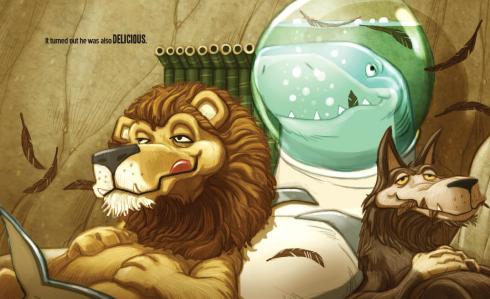
I am a collector of ideas. And so are you. Every idea you can get your grubby little mitts on.
How you keep them is up to you. I don’t keep my dragonflies in a cage. Or even a journal. I put them under a rock. Literally. (I know…weird. Maybe it’s a boy thing.)
I have something in my office called an Idea Rock.

And EVERY idea that flits my way gets captured, no matter where I am, no matter what I’m doing. You can see in the picture…there are ideas captured on 1000-Island-Dressing-stained-napkins that I got while eating rueben sandwiches. There are post-it-note ideas. There’s even a wedding program with an idea on it under there (man, that wedding was boring). I go through life with the assumption that every idea holds book-worthy potential, that no idea is inconsequential, therefore, they all get captured. They get put under the rock, and from there, they’re going nowhere (that rock is really heavy). And so, even if they do get momentarily judged (as ideas and dragonflies will), they never get dismissed, so they never get forgotten.
I have hundreds of ideas under there…more than I’ll ever be able to write in ten lifetimes. They’re not all gold. They won’t all become books. But they are all CAUGHT.
So put your judgement away and get your net ready. Because that buzzing you hear may just become your next book.

Aaron Reynolds is a New York Times Bestselling Author and has written many highly acclaimed books for kids, including Here Comes Destructosaurus!, Carnivores, the Joey Fly – Private Eye graphic novel series, and the Caldecott Honor Winning Creepy Carrots! He has a passion for kids’ books and seeing kids reading them. He regularly makes time to visit schools where his hilarious hands-on presentations keep kids spellbound. Aaron lives in Chicago with his wife, 2 kids, 4 cats, and anywhere between zero and ten goldfish, depending on the day.
You can visit him at www.aaron-reynolds.com.

Aaron is giving away one signed copy each of CREEPY CARROTS, CARNIVORES and HERE COMES DESTRUCTOSAURUS!
These prizes will be given away at the conclusion of PiBoIdMo. You are eligible for these prizes if:
- You have registered for PiBoIdMo.
- You have commented ONCE ONLY on today’s post.
- You have completed the PiBoIdMo challenge. (You will have to sign the PiBoIdMo Pledge at the end of the event.)
Good luck, everyone!


by Mylisa Larsen
Ladies and Gentlemen,
Today is the 27th of November. For some of you, that means you have 27 ideas lined up like jewels on your desk. I have nothing to say to you. Keep doing whatever it is you’ve been doing. Never mess with what’s working.
But some of you have only 17 ideas or 14 or [sigh] 9. Let me be frank. It is now time to panic.

by John (Flickr: Panic button)
Panic can be a great motivator. But there are two kinds of panic. Only one is going to be useful here. We want nothing to do with the kind of panic that says, “See, I knew I couldn’t do this. I knew I wasn’t the kind of person who could have thirty ideas.” Stop. Immediately. No one wants to be around you when you are like that. Especially muses.

We are going for an entirely different kind of panic. We are going for elevated pulse, eyes wide open, “well let’s try something completely new today because we have to get 15 ideas in the next 3 days and isn’t that going to be crazy fun” kind of panic. We are going for a “get out of your comfort zone and go drink the world in until it pours out in ideas” kind of panic.
So, here are 5 ideas for creative panicking:
- Are you sitting down at your desk? Why? That B.I.C. thing can be taken to an extreme, you know. If the ideas are not showing up at your desk, why are you still there? Why aren’t you out kayaking or dancing or sitting in a bubble bath? At the very least, you should be running through the halls yelling, “December is coming, December is coming.” People will just think you’re freaking out over holiday shopping so you’ll totally get away with it. But really, you’re signalling to your brain, “Today is not business as usual. Get out of your well worn little rut. We are going for a ride today.”
- Are you putting yourself where you can hear rhythm? We’ve already talked about dancing but you could also find some kids to play jump rope with. Play a clapping and rhyming game with the kids at the bus stop. Or climb up a tree and pay attention for awhile. The world is made of rhythms. So are a lot of picture books.
- Quick, who is your favorite illustrator? Go outside and look at everything as if it were one of their illustrations. What would that look like? What things would that illustrator notice or create out of what you are seeing? Try not to let yourself have words during this exercise. Just visuals. Then come back inside and pretend an editor has just called to say, “Edward Gorey/Diane Goode/Lane Smith/Pamela Zagarenski just called. They’d like to illustrate one of your books.” Write that book. Then pick another artist with a completely different sensibility and repeat.
- Wait, aren’t you going somewhere today to eat pie? This is perfect. Crazy relatives, frazzled toddlers, small children meeting Aunt Cora’s special jello for the first time. There will be stories there. Watch for them. Offer to entertain someone’s two year old. Remember what being two was like. Take all the young cousins out in the backyard and help them build a snowfort or rake leaves or play tag. They will love you for it. And you will find a story.
And if you aren’t meeting up with relatives for Thanksgiving, where are you going today? Because I’ll bet there’s a story there too.
- Look, the point is that panicking creatively is just about pulling out all the stops and flying at this task from some new angles. It’s about playing. So quit acting like such a grownup. When was the last time you sat down with some colored paper and cut it into shapes just because it was cool paper and you had scissors? When was the last time you laid on your belly in the grass and watched a tiny world go by? Have you drawn on your walls lately?
Loosen up a little. Grin like you have a secret. Play. Panic (creatively.)

 Mylisa Larsen has been telling stories for a long time. This has caused her to get gimlet-eyed looks from her parents, her siblings and, later, her own children when they felt that certain stories had been embellished beyond acceptable limits. She now writes children’s books where her talents for hyperbole are actually rewarded.
Mylisa Larsen has been telling stories for a long time. This has caused her to get gimlet-eyed looks from her parents, her siblings and, later, her own children when they felt that certain stories had been embellished beyond acceptable limits. She now writes children’s books where her talents for hyperbole are actually rewarded.
She is the author of the picture books, Instructions for Bedtime (Katherine Tegen Books, January 2016) and If I Were A Kangaroo (Viking).
You can visit her online at MylisaLarsen.com.

Mylisa is giving away a picture book critique!
This prize will be given away at the conclusion of PiBoIdMo. You are eligible for this prize if:
- You have registered for PiBoIdMo.
- You have commented ONCE ONLY on today’s post.
- You have completed the PiBoIdMo challenge. (You will have to sign the PiBoIdMo Pledge at the end of the event.)
Good luck, everyone!


by Ruth McNally Barshaw




 Ruth McNally Barshaw grew up in the Detroit area. When she was little she wanted to be an artist. She thought books were written by companies, not real people, so she didn’t want to write books. She changed her mind in 2002, and three years later connected with a fabulous agent who sold the first Ellie McDoodle book to Bloomsbury Children’s Books. Then it became a series.
Ruth McNally Barshaw grew up in the Detroit area. When she was little she wanted to be an artist. She thought books were written by companies, not real people, so she didn’t want to write books. She changed her mind in 2002, and three years later connected with a fabulous agent who sold the first Ellie McDoodle book to Bloomsbury Children’s Books. Then it became a series.
She is the author-illustrator of the six Ellie McDoodle Diaries (often compared to Diary of a Wimpy Kid). She’s the illustrator of Leopold is Lost, by Denise Brennan-Nelson, due out in 2015 with Sleeping Bear Press. And she is author-illustrator of several other picture books currently in various stages of development.
She and her writer-husband Charlie frequently take their story creation workshop on the road to schools, libraries and conferences. Otherwise you can find them at home or at a local bookstore, writing.
View Ruth’s artwork, books, and workshop details at RuthExpress.com and connect with her on Twitter @ruthexpress.

You can win a signed-and-doodled copy of Ruth’s latest Ellie McDoodle book! It’s not a picture book, but it does have art on every page.

This prize will be given away at the conclusion of PiBoIdMo. You are eligible for this prize if:
- You have registered for PiBoIdMo.
- You have commented ONCE ONLY on today’s post.
- You have completed the PiBoIdMo challenge. (You will have to sign the PiBoIdMo Pledge at the end of the event.)
Good luck, everyone!


 by Liz Garton Scanlon
by Liz Garton Scanlon
Recently, while discussing poetry with a bunch of 5th graders, I discovered a word that’s pretty much left our daily vernacular: loafe.
Whitman used it in SONG OF MYSELF…
I loafe and invite my soul
I lean and loafe at my ease observing a spear of summer grass
…but not a single student knew what the word meant. There were jokes about loaves of bread, and one girl thought she had it, but it turns out she’d gotten it mixed up with loathe. Which, you’ll agree, is another thing entirely.

Image via becuo.com
Once I defined the word for them, they loved it. I said, “Pretty great, right? To be given permission–even encouragement–to loafe about?!” and everybody laughed with relief. (Except for one boy who said, “I try to loafe about a LOT, but my mom won’t let me.” :-) )
So I stepped away from the session with kind of a two-part reminder to myself, and since it’s fresh on my mind, I’ll remind you, too:
- Loafe about. Seriously. Creativity can’t be rushed. You need to absorb before you can express. You need to walk and garden and bathe and dream and breathe. These things are the stuff that art is made of, the places ideas come from, the source of a sustained head and heart. Really, loafing about isn’t just important when making picture books–it’s important when living life. Professor Omid Safi asked, in a recent column called The Disease of Being Busy, “When did we forget that we are human beings, not human doings?” We know this, right? Right. This is just a reminder.
.
- And here’s the other one. Let’s not let really great words like loafe go by the by. Let’s use them. I snuck the word kin into my book ALL THE WORLD, and strut into NOODLE & LOU. I used crimp in THE GOOD-PIE PARTY and hue in THINK BIG. These words are evocative and specific and rich and onomatopoeic–they’re too good to let go! And, as writers, it’s our duty to make sure that we’re not just left with a bunch of OMGs and LOLs on judgment day.
How about you make a list of words you used to hear and use, but never do anymore? What if you wrote down all the phrases your granddad used to say? And what if one of them gave you an idea? Picture books aren’t designed to dumb down; they’re meant to open up and out.  They’re meant to expand the words and the world that a child has at hand. Lucky us to be a part of all that.
They’re meant to expand the words and the world that a child has at hand. Lucky us to be a part of all that.
So go ahead, make that list.
And then, what the heck, loafe about for a bit.

Liz Garton Scanlon is the author of the highly-acclaimed Caldecott-honored children’s book All the World, illustrated by Marla Frazee, as well as this year’s The Good-Pie Party, illustrated by Kady McDonald Denton. Other books include Happy Birthday, Bunny; Think Big, A Sock is a Pocket for Your Toes, and more. Her next picture book (called In The Canyon) and her first novel for young readers, The Great Good Summer, are both due in 2015. Ms. Scanlon is also a poet, teacher and a frequent and popular presenter at schools, libraries and conferences. To learn more, visit her web site at LizGartonScanlon.com.

Liz is giving away two copies of her latest picture book, THE GOOD-PIE PARTY! (YUMMY!)

These prizes will be given away at the conclusion of PiBoIdMo. You are eligible for these prizes if:
- You have registered for PiBoIdMo.
- You have commented ONCE ONLY on today’s post.
- You have completed the PiBoIdMo challenge. (You will have to sign the PiBoIdMo Pledge at the end of the event.)
Good luck, everyone!


 by Vesper Stamper
by Vesper Stamper
When I was growing up as a latch key kid in New York, two things formed my sense of place and identity in the world: my grandfather’s freckled arms and my picture books. There is something about visualizing a chosen reality that is so vital for kids as they transition from the Waldorf educational concept of the childhood dream-world to the brass-tacks world of adults. In a picture book, the world is presented as navigable, even through challenge. Whether the challenge is fear of closing one’s eyes to sleep, or losing a favorite bunny, or getting through the classic Grimms’ three-challenge arc, kids need to know that on the other side of something insurmountable is a green valley brimming with potential.
I am currently in the MFA program in Illustration as Visual Essay at School of Visual Arts, and most of the work I’m doing is a departure from my usual picture book work that you see here. I’m exploring my grandmother’s aging in one book project, and writing a love story set in post-Holocaust Germany which I will be illustrating this spring. I had a bit of a crisis about this, especially since I just signed with Rodeen Literary Management this summer and we’re just about to send one of my picture books out. But I realized that much of my work, even for kids, has to do with thriving after trauma, and that by exploring these more “adult” themes in my MFA, my picture book work will become more nuanced.


Far from being just about cute stories, picture books are the vehicle for survival for many kids as they were for me. That is why they are so, so
important. And…they’re gorgeous to look at!
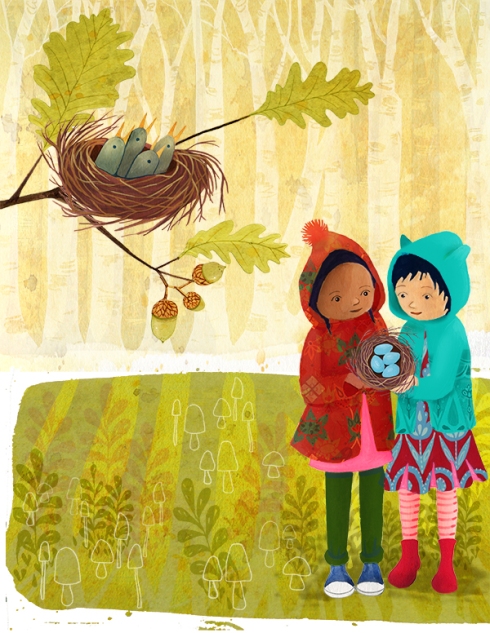






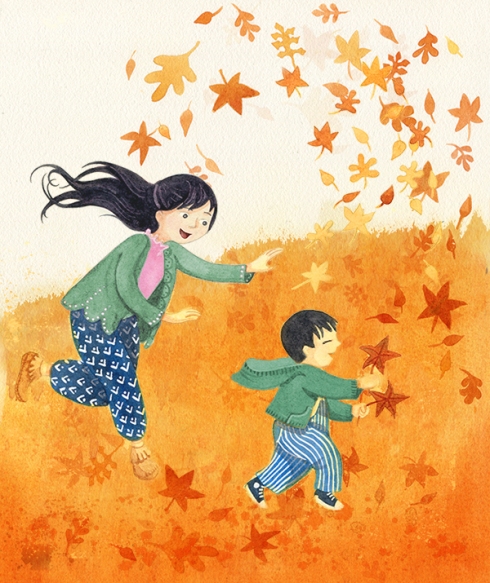
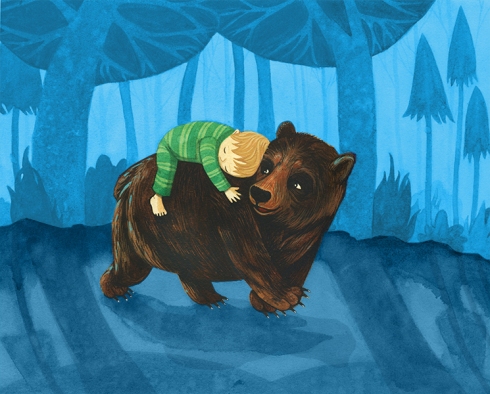
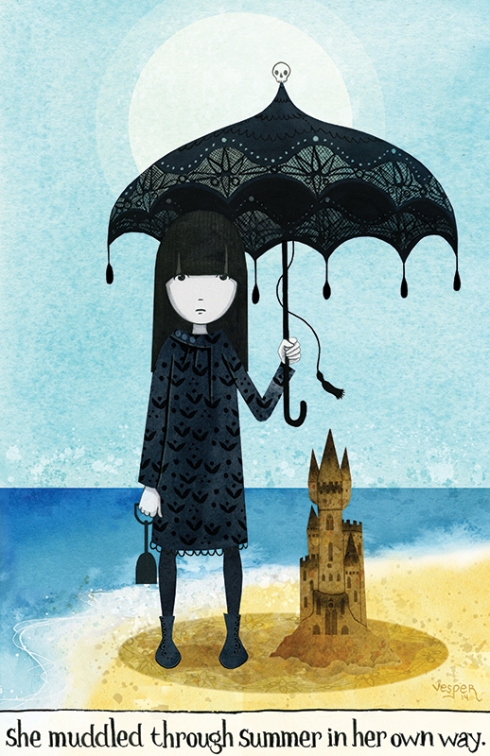

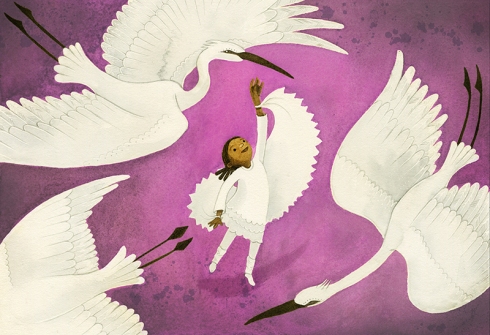

Hopelessly lost among the wintry wardrobes of Pauline Baynes’ Narnia, Shaun Tan’s mysterious foreign lands, and the watery open spaces in Lisbeth Zwerger’s illustrations, Vesper Stamper’s calling as an illustrator began when she cracked open Hilary Knight’s Cinderella and spent the rest of her childhood meticulously copying each graceful page.
Vesper has a BFA degree in Illustration with Honors from Parsons School of Design. Her career has spanned fifteen years, dozens of album covers, four picture books and countless other exciting projects. Vesper brings a refined style and emotional depth to her work that pays homage to the rich illustrative tradition from which she comes.
Vesper was named the 2013 People’s Choice Finalist in the Lilla Rogers Global Talent Search and is the recipient of the 2012 Lincoln City Fellowship for her graphic novel, The Sea-King’s Children. She lives in Jersey City, NJ with her husband, filmmaker Ben Stamper, and their two children. She is the winner of both the 2014 NJ SCBWI Juried Show and People’s Choice awards, and is an MFA candidate in the Illustration as Visual Essay at School of Visual Arts, NYC.
Vesper is represented by Lori Kilkelly at Rodeen Literary Management, Inc.



By:
Tara Lazar,
on 11/24/2014
Blog:
Tara Lazar
(
Login to Add to MyJacketFlap)
JacketFlap tags:
PiBoIdMo 2014,
Picture Books,
Rachel Orr,
Erin Murphy,
Ammi-Joan Paquette,
Stephen Fraser,
Heather Alexander,
Susan Hawk,
Joanna Volpe,
Kathleen Rushall,
Tricia Lawrence,
Kirsten Hall,
Add a tag
I asked the kidlit agents participating in PiBoIdMo as your “grand prizes” to tell us why they love picture books. Their answers are sure to inspire!
Heather Alexander, Pippin Properties
 Picture books are easy to love because they are tiny little windows that offer beautiful glimpses out into the whole, wide, wonderful world, and into hearts like and unlike our own.
Picture books are easy to love because they are tiny little windows that offer beautiful glimpses out into the whole, wide, wonderful world, and into hearts like and unlike our own.
Stephen Fraser, Jennifer De Chiara Literary Agency
 I do love picture books! There is nothing more satisfying that to find a picture book manuscript which has been carefully crafted to share a story with the youngest readers. The Impressionist painter Pierre Auguste Renoir said that painting is “making love visible” and I can’t help thinking that is why some picture books are so endearing and everlasting. They make the love we feel for our children, our grandchildren, and the children within us very visible. It is a true craft which needs to be learned and practiced. And I honor those who learn this craft and honor children.
I do love picture books! There is nothing more satisfying that to find a picture book manuscript which has been carefully crafted to share a story with the youngest readers. The Impressionist painter Pierre Auguste Renoir said that painting is “making love visible” and I can’t help thinking that is why some picture books are so endearing and everlasting. They make the love we feel for our children, our grandchildren, and the children within us very visible. It is a true craft which needs to be learned and practiced. And I honor those who learn this craft and honor children.
Kirsten Hall, Catbird Agency
 Picture books pretty much have me wrapped around their finger. I’m obsessed by the story-telling opportunities offered by this highly-visual genre! Picture books (as a format) seem simple at first blush, but they are often in fact quite layered and even poetic, displaying an elegant interplay between text and art. Best of all, picture books are accessible to everyone. You don’t have to be able to read in order to love them. They can be savored for what they offer visually, and when read aloud, until a reader has command over the written word. Simply, what format is better than the first one that takes children by the hand and turns them into book-lovers?
Picture books pretty much have me wrapped around their finger. I’m obsessed by the story-telling opportunities offered by this highly-visual genre! Picture books (as a format) seem simple at first blush, but they are often in fact quite layered and even poetic, displaying an elegant interplay between text and art. Best of all, picture books are accessible to everyone. You don’t have to be able to read in order to love them. They can be savored for what they offer visually, and when read aloud, until a reader has command over the written word. Simply, what format is better than the first one that takes children by the hand and turns them into book-lovers?
Susan Hawk, The Bent Agency
 The best part of picture books, for me, is way words and illustration marry together to create a sum greater than its parts. I love the way art builds meaning in the story, and how the simplest of texts can be full of emotion and heart. I remember so well the picture books that I poured over as a child — mystified and delighted to be invited into the world of reading and books. For me, it’s an honor to represent picture books!
The best part of picture books, for me, is way words and illustration marry together to create a sum greater than its parts. I love the way art builds meaning in the story, and how the simplest of texts can be full of emotion and heart. I remember so well the picture books that I poured over as a child — mystified and delighted to be invited into the world of reading and books. For me, it’s an honor to represent picture books!
Tricia Lawrence, Erin Murphy Literary Agency
 I love picture books because they celebrate a time in our life we all look back on so fondly. I love being a part of helping to create them because we’re creating books for kids who will look back on them for the rest of their lives.
I love picture books because they celebrate a time in our life we all look back on so fondly. I love being a part of helping to create them because we’re creating books for kids who will look back on them for the rest of their lives.
Erin Murphy, Erin Murphy Literary Agency
 I became a reader because of picture books, and I became an agent because of picture books. They are one of the richest and most influential forms of literature. So much feeling, so many laughs, in so few pages, meant to be read over and over again!
I became a reader because of picture books, and I became an agent because of picture books. They are one of the richest and most influential forms of literature. So much feeling, so many laughs, in so few pages, meant to be read over and over again!
Ammi-Joan Paquette, Erin Murphy Literary Agency
 I love picture books because they speak to the quintessential child in each of us. They reach across the gaps of age and culture and language and bring us under their spell. A perfectly-crafted picture book is a full-senses experience that can last a lifetime.
I love picture books because they speak to the quintessential child in each of us. They reach across the gaps of age and culture and language and bring us under their spell. A perfectly-crafted picture book is a full-senses experience that can last a lifetime.
Rachel Orr, Prospect Agency
 I love the breadth of story and emotion—from clever and comical, to poetic and pondering—that can be found within the framework of a 32-page picture book. I love the right prose, the visual subplots, the rhythm and rhyme and repetition (and repetition, and repetition). But, most of all, I love them because they’re short.
I love the breadth of story and emotion—from clever and comical, to poetic and pondering—that can be found within the framework of a 32-page picture book. I love the right prose, the visual subplots, the rhythm and rhyme and repetition (and repetition, and repetition). But, most of all, I love them because they’re short.
Kathleen Rushall, Marsal Lyon Literary Agency
 I love working with picture books because they remind me that the earliest literature we read in life can be some of the most memorable (and the most fun!).
I love working with picture books because they remind me that the earliest literature we read in life can be some of the most memorable (and the most fun!).
Joanna Volpe, New Leaf Literary & Media, Inc.
 I love picture books because they’re fun to read aloud, and they’re meant to be read with someone else.They can’t not be shared! Even now, I don’t have kids, but when I read a good picturebook, my husband gets to be the audience. He’s very understanding. :-)
I love picture books because they’re fun to read aloud, and they’re meant to be read with someone else.They can’t not be shared! Even now, I don’t have kids, but when I read a good picturebook, my husband gets to be the audience. He’s very understanding. :-)


View Next 25 Posts





 Mira Reisberg is an award-winning children’s book creative, a former kidlit university professor and a former literary agent. She is also the Director of the Children’s Book Academy and has taught many now highly successful authors and illustrators. Visit her at childrensbookacademy.com.
Mira Reisberg is an award-winning children’s book creative, a former kidlit university professor and a former literary agent. She is also the Director of the Children’s Book Academy and has taught many now highly successful authors and illustrators. Visit her at childrensbookacademy.com.




















 by
by 





 by
by 




 by
by 



























 by
by 

 by
by 



 by
by 






 Cece Bell lives in an old church with her husband, author Tom Angleberger, and she works right next door in a new-ish barn. El Deafo, her first graphic novel, is a slightly fictionalized memoir about her childhood, her hearing loss, her first crush, and her quest for a true friend. She has written and illustrated other books for children, including the Geisel Honor book Rabbit & Robot: The Sleepover; Itty Bitty; Bee-Wigged; and the Sock Monkey series. You can read more about her at
Cece Bell lives in an old church with her husband, author Tom Angleberger, and she works right next door in a new-ish barn. El Deafo, her first graphic novel, is a slightly fictionalized memoir about her childhood, her hearing loss, her first crush, and her quest for a true friend. She has written and illustrated other books for children, including the Geisel Honor book Rabbit & Robot: The Sleepover; Itty Bitty; Bee-Wigged; and the Sock Monkey series. You can read more about her at 

 ***To everyone who completed the PiBoIdMo Challenge, the Pledge for you to sign is coming later today. In the meantime, enjoy our first Post-PiBo guest blog with a very talented illustrator!***
***To everyone who completed the PiBoIdMo Challenge, the Pledge for you to sign is coming later today. In the meantime, enjoy our first Post-PiBo guest blog with a very talented illustrator!***







 by Tara Lazar
by Tara Lazar


 by
by 



 by
by 




 Mylisa Larsen has been telling stories for a long time. This has caused her to get gimlet-eyed looks from her parents, her siblings and, later, her own children when they felt that certain stories had been embellished beyond acceptable limits. She now writes children’s books where her talents for hyperbole are actually rewarded.
Mylisa Larsen has been telling stories for a long time. This has caused her to get gimlet-eyed looks from her parents, her siblings and, later, her own children when they felt that certain stories had been embellished beyond acceptable limits. She now writes children’s books where her talents for hyperbole are actually rewarded.


 Ruth McNally Barshaw grew up in the Detroit area. When she was little she wanted to be an artist. She thought books were written by companies, not real people, so she didn’t want to write books. She changed her mind in 2002, and three years later connected with a fabulous agent who sold the first Ellie McDoodle book to Bloomsbury Children’s Books. Then it became a series.
Ruth McNally Barshaw grew up in the Detroit area. When she was little she wanted to be an artist. She thought books were written by companies, not real people, so she didn’t want to write books. She changed her mind in 2002, and three years later connected with a fabulous agent who sold the first Ellie McDoodle book to Bloomsbury Children’s Books. Then it became a series.
 by
by 

 by
by 














 Picture books are easy to love because they are tiny little windows that offer beautiful glimpses out into the whole, wide, wonderful world, and into hearts like and unlike our own.
Picture books are easy to love because they are tiny little windows that offer beautiful glimpses out into the whole, wide, wonderful world, and into hearts like and unlike our own. I do love picture books! There is nothing more satisfying that to find a picture book manuscript which has been carefully crafted to share a story with the youngest readers. The Impressionist painter Pierre Auguste Renoir said that painting is “making love visible” and I can’t help thinking that is why some picture books are so endearing and everlasting. They make the love we feel for our children, our grandchildren, and the children within us very visible. It is a true craft which needs to be learned and practiced. And I honor those who learn this craft and honor children.
I do love picture books! There is nothing more satisfying that to find a picture book manuscript which has been carefully crafted to share a story with the youngest readers. The Impressionist painter Pierre Auguste Renoir said that painting is “making love visible” and I can’t help thinking that is why some picture books are so endearing and everlasting. They make the love we feel for our children, our grandchildren, and the children within us very visible. It is a true craft which needs to be learned and practiced. And I honor those who learn this craft and honor children. Picture books pretty much have me wrapped around their finger. I’m obsessed by the story-telling opportunities offered by this highly-visual genre! Picture books (as a format) seem simple at first blush, but they are often in fact quite layered and even poetic, displaying an elegant interplay between text and art. Best of all, picture books are accessible to everyone. You don’t have to be able to read in order to love them. They can be savored for what they offer visually, and when read aloud, until a reader has command over the written word. Simply, what format is better than the first one that takes children by the hand and turns them into book-lovers?
Picture books pretty much have me wrapped around their finger. I’m obsessed by the story-telling opportunities offered by this highly-visual genre! Picture books (as a format) seem simple at first blush, but they are often in fact quite layered and even poetic, displaying an elegant interplay between text and art. Best of all, picture books are accessible to everyone. You don’t have to be able to read in order to love them. They can be savored for what they offer visually, and when read aloud, until a reader has command over the written word. Simply, what format is better than the first one that takes children by the hand and turns them into book-lovers? The best part of picture books, for me, is way words and illustration marry together to create a sum greater than its parts. I love the way art builds meaning in the story, and how the simplest of texts can be full of emotion and heart. I remember so well the picture books that I poured over as a child — mystified and delighted to be invited into the world of reading and books. For me, it’s an honor to represent picture books!
The best part of picture books, for me, is way words and illustration marry together to create a sum greater than its parts. I love the way art builds meaning in the story, and how the simplest of texts can be full of emotion and heart. I remember so well the picture books that I poured over as a child — mystified and delighted to be invited into the world of reading and books. For me, it’s an honor to represent picture books! I love picture books because they celebrate a time in our life we all look back on so fondly. I love being a part of helping to create them because we’re creating books for kids who will look back on them for the rest of their lives.
I love picture books because they celebrate a time in our life we all look back on so fondly. I love being a part of helping to create them because we’re creating books for kids who will look back on them for the rest of their lives. I became a reader because of picture books, and I became an agent because of picture books. They are one of the richest and most influential forms of literature. So much feeling, so many laughs, in so few pages, meant to be read over and over again!
I became a reader because of picture books, and I became an agent because of picture books. They are one of the richest and most influential forms of literature. So much feeling, so many laughs, in so few pages, meant to be read over and over again! I love picture books because they speak to the quintessential child in each of us. They reach across the gaps of age and culture and language and bring us under their spell. A perfectly-crafted picture book is a full-senses experience that can last a lifetime.
I love picture books because they speak to the quintessential child in each of us. They reach across the gaps of age and culture and language and bring us under their spell. A perfectly-crafted picture book is a full-senses experience that can last a lifetime. I love the breadth of story and emotion—from clever and comical, to poetic and pondering—that can be found within the framework of a 32-page picture book. I love the right prose, the visual subplots, the rhythm and rhyme and repetition (and repetition, and repetition). But, most of all, I love them because they’re short.
I love the breadth of story and emotion—from clever and comical, to poetic and pondering—that can be found within the framework of a 32-page picture book. I love the right prose, the visual subplots, the rhythm and rhyme and repetition (and repetition, and repetition). But, most of all, I love them because they’re short. I love working with picture books because they remind me that the earliest literature we read in life can be some of the most memorable (and the most fun!).
I love working with picture books because they remind me that the earliest literature we read in life can be some of the most memorable (and the most fun!). I love picture books because they’re fun to read aloud, and they’re meant to be read with someone else.They can’t not be shared! Even now, I don’t have kids, but when I read a good picturebook, my husband gets to be the audience. He’s very understanding.
I love picture books because they’re fun to read aloud, and they’re meant to be read with someone else.They can’t not be shared! Even now, I don’t have kids, but when I read a good picturebook, my husband gets to be the audience. He’s very understanding.
Fantastic post. Thanks!
Ditto what Becky said. Very informative, easy-to-follow post. Thanks, ladies!
I miss reading these each day, thanks so much for the post!
This is EXACTLY what I’m dealing with today. Thank you universe and @taralazar
So anxious to start this course. I’m rewriting a ms I cut way back thinking it was a PB. Wrong. :-) Now adding detail to enhance what I have. Fun.
Fantastic post! I’ve linked it in the Writers’ Rumpus resources page, and put it on our FB page too. Plus I emailed it to the whole critique group list. THANK YOU!
Excellent as usual.
Great post! It really is a difficult call sometimes. These are great pointers.
Reblogged this on make every word count.
Thank you, Tara & Mira! Great post. I have a client to send to you.
Oops! And Hillary! I just don’t know you yet… Glad to meet you!